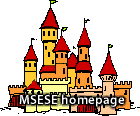|
Divergent
Boundaries
Places where plates are coming apart are called divergent boundaries.
As shown in the drawing above, when Earth's brittle surface layer
(the lithosphere) is pulled apart, it typically breaks along parallel
faults that tilt slightly outward from each other. As the plates
separate along the boundary, the block between the faults cracks
and drops down into the soft, plastic interior (the asthenosphere).
The sinking of the block forms a central valley called a rift. Magma
(liquid rock) seeps upward to fill the cracks. In this way, new
crust is formed along the boundary. Earthquakes occur along the
faults, and volcanoes form where the magma reaches the surface.
Where a
divergent boundary crosses the land, the rift valleys which form
are typically 30 to 50 kilometers wide. Examples include the
East Africa rift in Kenya and Ethiopia, and the Rio Grande rift
in New Mexico. Where a divergent boundary crosses the ocean floor,
the rift valley is much narrower, only a kilometer or less across,
and it runs along the top of a midoceanic ridge. Oceanic ridges
rise a kilometer or so above the ocean floor and form a global network
tens of thousands of miles long. Examples include the Mid-Atlantic
ridge and the East Pacific Rise.
Plate separation
is a slow process. For example, divergence along the Mid Atlantic
ridge causes the Atlantic Ocean to widen at only about 2 centimeters
per year.
Back
| Next
|











